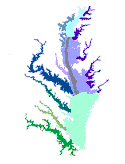History
From July 1980 to June 1984, 33 stations were sampled ten times each year. The distribution of sampling stations encompassed a large portion of the mesohaline zone within the mainstem of the Bay and the Potomac River estuary. Sampling efforts were particularly intensive near the Calvert Cliffs and Morgantown Steam Electric Plants. July 1984-June 1989The Maryland Chesapeake Bay Long-Term Benthic Monitoring Program began monitoring benthic community health bay-wide in 1984. In the first five years of the program, 70 fixed stations were sampled eight to ten times per year. On each visit, three benthic samples were collected at each station and processed. July 1989-June 1994In the second five years of the program, fixed site sampling was continued at 29 stations, and a stratified random sampling element was added. Samples were collected at random from approximately 25 km2 small areas surrounding these stations to assess the representativeness of the fixed locations. In addition, four new areas were established in regions of the Bay targeted for management actions to abate pollution: the Patuxent River, Choptank River, and two areas in Baltimore Harbor. Each area was sampled four to six times each year. July 1994-PresentSince 1994, the Chesapeake Bay Benthic Monitoring Program has consisted of two elements: a fixed-site monitoring sampling effort directed at identifying trends in benthic condition, and a probability-based sampling effort intended to estimate the area of the Maryland Chesapeake Bay with benthic communities meeting and failing to meet the Chesapeake Bay Program’s Benthic Community Restoration Goals.
|
